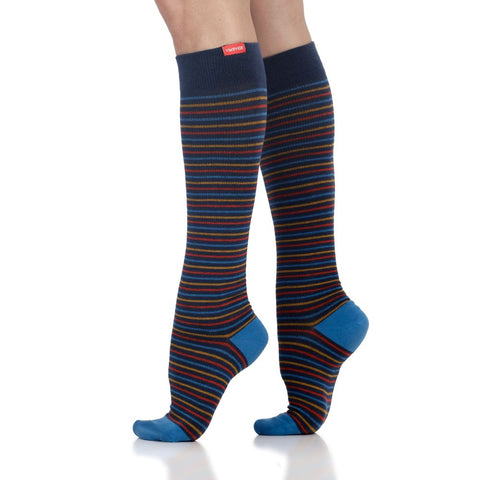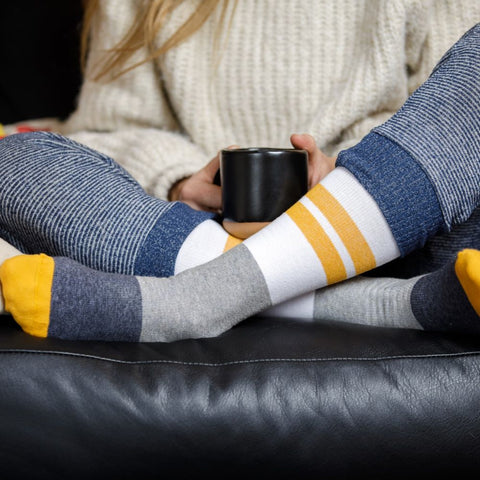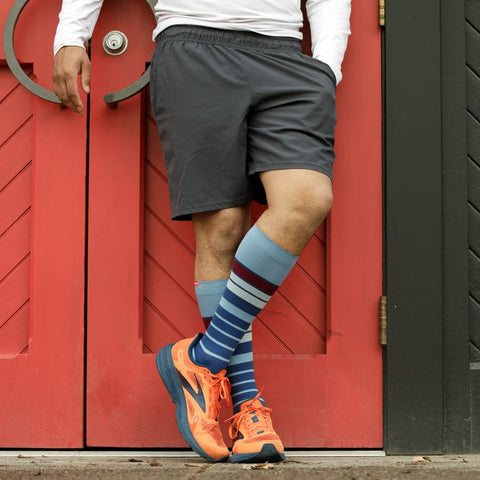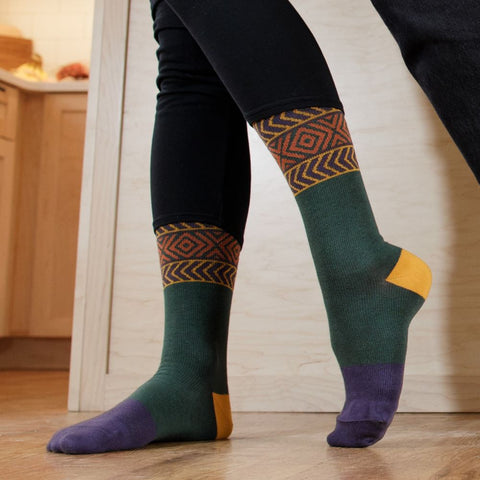Should You Wear Compression Socks for Metatarsalgia?
Foot pain can be extremely debilitating - after all, we’re on our feet a lot every day! Metatarsalgia, a pain in the area known as the “ball of the foot,” affects those suffering from certain medical conditions, but can also occur when you wear poorly fitting shoes or when you’re dealing with a stress fracture, among other scenarios.
Thanks to how compression socks squeeze the feet, adding support and boosting blood flow in the area, they could come to your aid when suffering from metatarsalgia.
In this article, we’ll cover:
- Why compression socks help with symptoms of metatarsalgia;
- Their benefits;
- How to wear them;
- What other complementary treatment options you should consider.

Do Compression Socks Help Metatarsalgia?
Compression socks work in two main ways to improve metatarsalgia symptoms: they boost peripheral circulation and offer support to the joints in the lower legs.
An increase in blood flow to the feet and back up towards the heart (stimulated by graduated compression) ensures that feet don’t get cold or numb, while decreasing the chances of feet swelling. However, for metatarsalgia, the key benefit is that improved blood flow reduces inflammation, which can lead to pain relief.
Since compression socks squeeze the feet, the pressure they apply acts as an added support to the arch of the foot, also delivering a gentle massage. This adds to the pain relief, but can also help prevent discomfort and pain in the future and reduce the likelihood of another metatarsalgia episode.
What is Metatarsalgia?
Metatarsalgia is the medical term for when the ball of your foot feels painful, as it’s become inflamed. It’s sometimes caused by running and jumping, where you put more stress on the forefoot than normal. But it can also be brought on by medical conditions, injuries, or simply poorly fitting shoes.
The metatarsals are the bones in the forefoot that connect the phalanges (more or less the toes) with the midfoot. There is one for each toe and the point at which the area becomes painful is what we refer to as the “ball of the foot.”
What does metatarsalgia feel like? Here are some key symptoms:
- A sharp ache or burning pain in the ball of the foot
- The pain worsens when you flex your foot (standing on your toes) or when you stand, run, or walk, especially barefoot on a hard surface
- You feel better when you rest
- There can be tingling sensations in the toes or they can go numb
- It can feel like you have something in your shoe.

Benefits of Compression Socks for Metatarsalgia
While there are many specific metatarsalgia treatments, usually prescribed by a doctor, wearing compression socks can help prevent metatarsal pain and reduce the symptoms when it occurs. Here’s how.
Pain Relief and Reduction of Inflammation
Metatarsalgia patients suffer from inflammation in the ball of the foot, which leads to aches and pains. By boosting blood flow to the feet and lower legs, compression socks can reduce inflammation, thereby providing important pain relief.
Improved Blood Circulation
Boosting blood flow is the key way in which compression socks act on the lower legs. Graduated compression socks are tighter towards the feet and looser towards the knees, supporting blood traveling up to the heart and reducing the risk of swollen feet and ankles. That’s one less possible complication you won’t need to worry about!
Improved blood flow also reduces the risk of numb or tingling feet.
Support for the Arch and Metatarsal Area
The tight grip that compression socks have on the feet and legs is supportive and reassuring. Many athletes return to sport after stress fractures or sprains wearing compression socks in the beginning, enjoying the added support to the joints. These socks also feel supportive throughout the foot, including the arch and the metatarsal area, providing welcome stability when walking or running.
Prevention of Further Complications
By reducing inflammation and the risk of swelling, compression socks can play an important role in preventing other foot and lower leg health problems. They are a great preventative measure against developing varicose veins or blood clots, for example. Compression therapy, overall, is recommended for better recovery after efforts and for improved peripheral circulation.

How to Wear Compression Socks for Metatarsalgia Relief
Getting relief from foot pain will be your first priority when you suffer from metatarsalgia. With compression socks, this can be done wherever you are - all you need to do is put on your socks.
You can wear compression socks for as long as you feel comfortable, but we recommend starting out with a few hours at a time, especially if you’ve never worn them before. This gives the body some time to adjust to the feeling of squeezing the lower legs.
Compression socks are effective as a preventative measure, meaning that you can wear them ahead of events like long-haul flights when you know you’ll be sitting still for a long period of time, or ahead of tennis matches, runs, or other sporting events. They improve peripheral circulation, essentially “warming up” the muscles and joints, which reduces the risk of injury.
During flights, playing sports, or standing for long periods of time at work, compression socks keep massaging the lower legs and providing support for the ankles and feet. And, afterwards, putting your feet up while letting your compression socks massage the legs and ensure that blood is traveling to the muscles with much-needed oxygen and nutrients is an integral part of effective recovery.

Choosing Compression Socks for Metatarsalgia
To get the full benefits of compression, you need to ensure that you have the right size socks and that you’re wearing a fabric and compression level appropriate for your activity.
Sizing is essential. If compression socks fit too tight, they risk cutting off the circulation, which is the opposite of what you’re trying to achieve by wearing them. But, if they’re too loose, then you won’t get any benefit. Ensure you follow a professional sizing guide and start by measuring your calf circumference to get the best fit.
Fabric choice depends on your activity levels, weather conditions, and personal preference. For those likely to get sweaty feet during intense activity, merino wool is a safe choice as it helps regulate temperature and keep your feet dry. Cotton is great for everyday wear, while nylon is sleek and flexible for playing sports.
The last piece of the puzzle is compression level. This shows how tight the socks are and is measured in mmHg. For first-time users and especially during everyday scenarios, moderate compression at 15-20 mmHg is just perfect. Those who have circulatory problems and have already discussed with their doctors may opt for 20-30 mmHg, and there are prescription-only medical grade socks that grip even tighter.
Complementary Metatarsalgia Treatment Options
While compression socks can relieve pain, discomfort, and swelling, they are not the only accessible way to treat metatarsalgia symptoms. Here are some other options.
Rest, Ice, and Elevation
With any injury and inflammation, the “golden trio” of rest, ice, and elevation represent an effective first action to relieve pain. Sometimes, this will be all it takes to get over the initial onset. You can also wear your compression socks while you keep your feet elevated.
Proper Footwear and Orthotics
Many cases of metatarsalgia are caused by inappropriate footwear - either too small, or not adapted to the activity you’re doing. Both too tight and too loose shoes should be avoided, as should wearing high heels.
You can also wear metatarsal pads which are available off-the-shelf and can be placed in the shoes to help relieve stress from the pain. Specialized insoles are also very effective against foot pain, or arch supports, depending on your situation.
Medical Interventions
Depending on the severity of your symptoms and any other medical conditions, you may be referred to a specialist doctor for further care. Metatarsalgia patients will often meet with an orthopedist (a bone specialist) or a podiatrist (a foot specialist). Either way, they will advise if further medical intervention is needed, such as medication or other avenues to tackle your case of metatarsalgia.



















Leave a comment